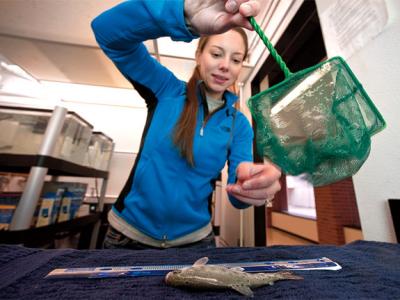Speed trap for fish catches domestic trout moving too slow

Kristy Bellinger has documented dramatic differences in the swimming ability of hatchery trout and their wilder relatives. Credit: Shelly Hanks, Washington State University
Washington State University researchers have documented dramatic differences in the swimming ability of domesticated trout and their wilder relatives. The study calls into question the ability of hatcheries to mitigate more than a century of disturbances to wild fish populations.
Kristy Bellinger, who did the study for her work on a Ph.D. in zoology, said traditional hatcheries commonly breed for large fish at the cost of the speed they need to escape predators in the wild.
“The use of hatcheries to support declining wild salmon and steelhead is controversial,” said Bellinger. “They have a role as being both a part of the solution in supplementing depleted stocks and as being a hindrance to boosting natural populations, as they often produce fish that look and behave differently from their wild relatives.”
Bellinger conducted the study with Gary Thorgaard, a nationally recognized fish geneticist and professor in WSU's School of Biological Sciences, and her advisor, Associate Professor Patrick Carter. Their work is published in the journal Aquaculture.
The study used a sort of speed trap for fish, a meter-long plastic tank filled with water and fitted with electronic sensors. Over 10 weeks, Bellinger repeatedly ran 100 clonal (genetically similar) hatchery-raised and semi-wild rainbow trout through the tank, clocking their speed and monitoring their growth from week to week. The clonal rainbow trout were propagated on the WSU campus.
The domesticated fish tended to grow faster. But while increased size is generally seen as a sign of fitness, the researchers saw that wasn't the case as far as speed is concerned. “The highly domesticated fish have bigger body sizes but slower swim speeds compared to the more wild lines that are smaller,” said Bellinger. “It is intuitive to think that the more you feed them, the more they're going to grow, the faster they're going to be, and that's what we see within each clonal line. However, between the lines, the domesticated fish were larger but slower sprinters.”
Over the past century, hatcheries have become a mainstay of recreational fishing, providing millions of trout and other salmonids to lakes and streams. More recently, hatcheries have come to be seen as tools in conserving native stocks. The state of Washington has more than 200 hatcheries, with most producing salmon and steelhead, an ocean-running trout, and about one-fourth producing trout and other game fish.
Hatchery managers, said Bellinger, tend to select for large fish.
“Fish managers want the biggest bang for their buck,” she said. “But if increased size is a tradeoff of sprint speed, as our data show, then we assume hatchery fish are being picked off by predators due to their slower speed, which makes the process of supplementing native fish with hatchery fish an inefficient tool for conservation and a waste of money.”
Media Contact
More Information:
http://www.wsu.edu/All latest news from the category: Agricultural and Forestry Science
Newest articles

New model of neuronal circuit provides insight on eye movement
Working with week-old zebrafish larva, researchers at Weill Cornell Medicine and colleagues decoded how the connections formed by a network of neurons in the brainstem guide the fishes’ gaze. The…

Innovative protocol maps NMDA receptors in Alzheimer’s-Affected brains
Researchers from the Institute for Neurosciences (IN), a joint center of the Miguel Hernández University of Elche (UMH) and the Spanish National Research Council (CSIC), who are also part of…

New insights into sleep
…uncover key mechanisms related to cognitive function. Discovery suggests broad implications for giving brain a boost. While it’s well known that sleep enhances cognitive performance, the underlying neural mechanisms, particularly…



